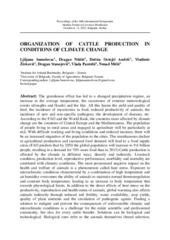Приказ основних података о документу
ORGANIZATION OF CATTLE PRODUCTION IN CONDITIONS OF CLIMATE CHANGE
| dc.creator | Samolovac, Ljiljana | |
| dc.creator | Nikšić, Dragan | |
| dc.creator | Ostojić Andrić, Dušica | |
| dc.creator | Živković, Vladimir | |
| dc.creator | Stanojević, Dragan | |
| dc.creator | Pantelić, Vlada | |
| dc.creator | Mićić, Nenad | |
| dc.date.accessioned | 2023-10-19T12:40:35Z | |
| dc.date.available | 2023-10-19T12:40:35Z | |
| dc.date.issued | 2023-10-04 | |
| dc.identifier.isbn | 978-86-82431-80-0 | |
| dc.identifier.uri | http://r.istocar.bg.ac.rs/handle/123456789/921 | |
| dc.description.abstract | The greenhouse effect has led to a changed precipitation regime, an increase in the average temperature, the occurrence of extreme meteorological events (droughts and floods) and the like. All this harms the yield and quality of feed, the incidence of mycotoxins in food, reduced productivity of animals, the incidence of new and non-specific pathogens, the development of diseases, etc. According to the FAO and the World Bank, the countries most affected by climate change are the countries of Central Europe and the Mediterranean. The population of people living in rural areas and engaged in agriculture will be particularly at risk. With difficult working and living conditions and reduced incomes, there will be an increased migration of the population to the cities. The simultaneous decline in agricultural production and increased food demand will lead to a food supply crisis (FAO predicts that by 2050 the global population will increase to 9.6 billion people, resulting in a demand for 70% more food than in 2013).Cattle production is affected by the climate in different ways, directly and indirectly. Livestock condition, production level, reproductive performance, morbidity and mortality are correlated with climatic conditions. The most pronounced negative impact on the health and welfare of animals is a phenomenon called heat stress. Exposure to microclimatic conditions characterized by a combination of high temperature and air humidity overcomes the ability of animals to maintain normal thermoregulation and constant body temperature, leading to an increase in body temperature that exceeds physiological limits. In addition to the direct effects of heat stress on the productivity, reproduction and health status of animals, global warming also affects animals indirectly through reduced soil fertility, water availability, crop yields, quality of plant nutrients and the circulation of pathogenic agents. Finding a solution to mitigate and prevent the consequences of unfavourable climatic and microclimatic conditions is a challenge for the entire scientific and professional community, but also for every cattle breeder. Solutions can be biological and technological. Biological ones refer to the animals themselves (breed selection, selection for functional traits, selection for adaptability to heat stress, use of genomic selection, artificial insemination programs, herd size). Technological solutions relate to how animals are kept (free system, in outlets with canopies, use of grazing), facilities (new materials and technical solutions in the construction of facilities, use of insulating materials, regulation of microclimate conditions in facilities - ventilation and air humidity), nutrition and feeding (feeding method, feeding time, use of new types of feed, continuous water supply, etc.).The goal of agricultural production is to ensure food security in the face of climate change, and it is one of the most demanding tasks facing humanity | sr |
| dc.language.iso | en | sr |
| dc.publisher | Institut za stočarstvo, Beograd-Zemun | sr |
| dc.relation | info:eu-repo/grantAgreement/MESTD/inst-2020/200022/RS// | sr |
| dc.rights | openAccess | sr |
| dc.rights.uri | https://creativecommons.org/licenses/by/4.0/ | |
| dc.source | Proceedings of the 14th International Symposium, "Modern Trends in Livestock Production", Belgrade, Serbia | sr |
| dc.subject | greenhouse effect | sr |
| dc.subject | climate change | sr |
| dc.subject | cattle production | sr |
| dc.title | ORGANIZATION OF CATTLE PRODUCTION IN CONDITIONS OF CLIMATE CHANGE | sr |
| dc.type | conferenceObject | sr |
| dc.rights.license | BY | sr |
| dc.citation.spage | 114 | |
| dc.citation.epage | 128 | |
| dc.identifier.rcub | https://hdl.handle.net/21.15107/rcub_ristocar_921 | |
| dc.identifier.fulltext | http://r.istocar.bg.ac.rs/bitstream/id/4372/bitstream_4372.pdf | |
| dc.type.version | publishedVersion | sr |


